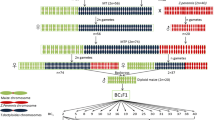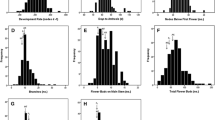Abstract
DNA fingerprinting verified hybrid plants obtained by crossing Eastern gamagrass, Tripsacum dactyloides L., and perennial teosinte, Zea diploperennis Iltis, Doebley & R. Guzmán. Pistillate inflorescences on these hybrids exhibit characteristics intermediate to the key morphological traits that differentiate domesticated maize from its wild relatives: (1) a pair of female spikelets in each cupule; (2) exposed kernels not completely covered by the cupule and outer glumes; (3) a rigid, non-shattering rachis; (4) a polystichous ear. RFLP analysis was employed to investigate the possibility that traits of domesticated maize were derived from hybridization between perennial teosinte and Tripsacum. Southern blots of restriction digested genomic DNA of parent plants, F1, and F2 progeny from two different crosses were probed with RFLP markers specifically associated with changes in pistillate inflorescence architecture that signal maize domestication. Pairwise analysis of restriction patterns showed traits considered missing links in the origin of maize correlate with alleles derived from Tripsacum, and the same alleles are stably inherited in second generation progeny from crosses between Tripsacum and perennial teosinte.
Similar content being viewed by others
Author information
Authors and Affiliations
Additional information
Received: 11 October 1996/Accepted:8 November 1996
Rights and permissions
About this article
Cite this article
Eubanks, M. Molecular analysis of crosses between Tripsacum dactyloides and Zea diploperennis (Poaceae). Theor Appl Genet 94, 707–712 (1997). https://doi.org/10.1007/s001220050469
Issue Date:
DOI: https://doi.org/10.1007/s001220050469




